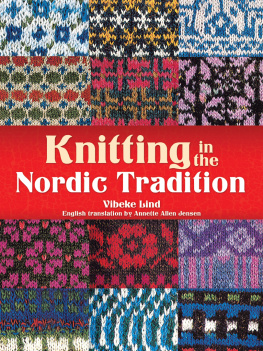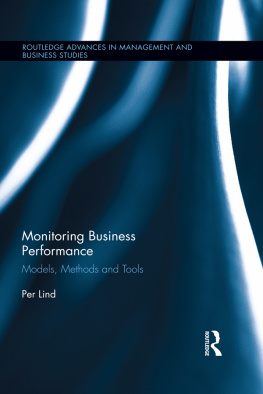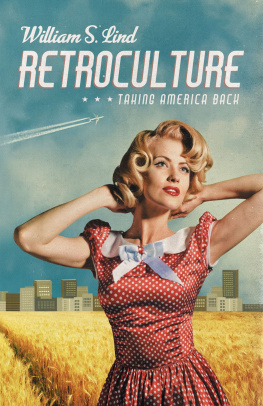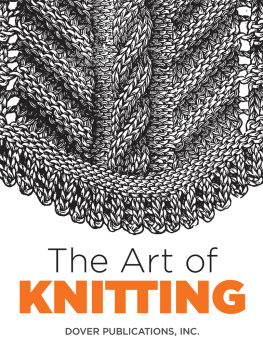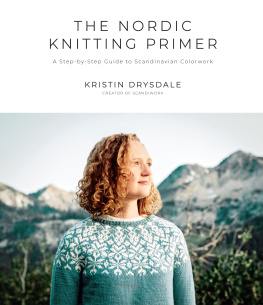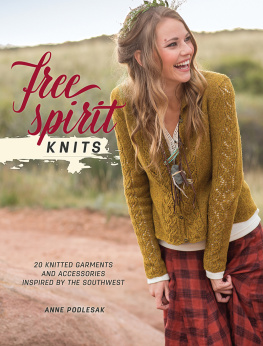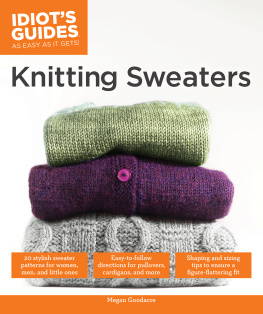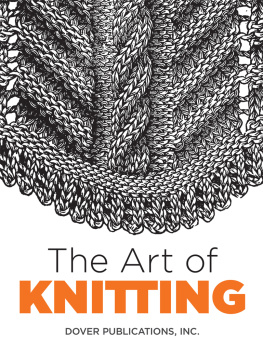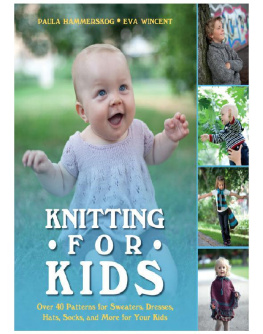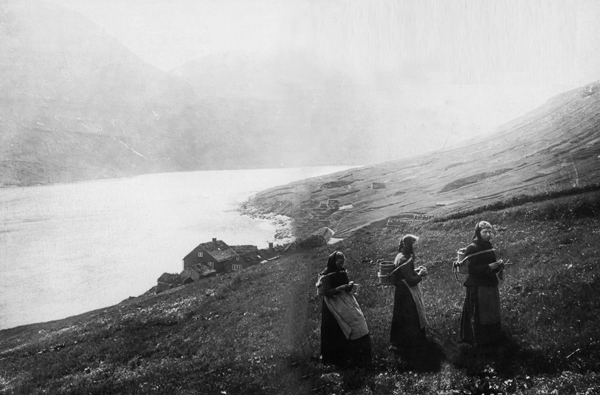
KNITTING IN THE
NORDIC TRADITION
VIBEKE LIND
English translation by
Annette Allen Jensen
DOVER PUBLICATIONS, INC.
MINEOLA, NEW YORK

A map by A. Ortelius, 1573
Copyright
First published in Denmark under the title Strik med Nordisk Tradition Vibeke Lind and Hst & Sns Forlag, Copenhagen 1981
English translation 1984 by Lark Books
Text 1998 by Sterling Publishing Co., Inc. under the title KNITTING IN THE NORDIC TRADITION.
All rights reserved.
Bibliographical Note
This Dover edition, first published in 2014, is an unabridged republication of the work, translated from the Danish by Annette Allen Jensen, originally published by Lark Books, Asheville, North Carolina, in 1984 and Sterling Publishing Co., Inc., New York, in 1998. This text has been published by arrangement with Sterling Publishing Co., Inc., 387 Park Ave. South, New York, NY 10016.
The original color plates have been gathered together as an eight-page color insert between pages .
Library of Congress Cataloging-in-Publication Data
Lind, Vibeke, author.
[Strik med nordisk tradition. English]
Knitting in the Nordic tradition / Vibeke Lind; English translation by Annette Allen Jensen.
pages cm
Summary: Richly illustrated with photos, charts, and drawings, this guide to Scandinavian knitting features patterns for childrens and adults sweaters, jackets, caps, mittens, stockings, and shawls. More than 100 graphed patterns in the authentic Nordic tradition are simple in cut and decoration, and they include suggestions for adaptations to individual needs and tastesProvided by publisher.
Includes bibliographical references and index.
eISBN-13: 978-0-486-79491-4
1. KnittingScandinavia. I. Title.
TT819.S26L5613 2014
746.4320948dc23
2013049853
Manufactured in the United States by Courier Corporation
78038401 2014
www.doverpublications.com
K nitted garments exist in many countries as a kind of national costume; that is, pieces of clothing with patterns and decorations that have been passed down from one generation to another. In Nordic knitting traditions examples are found in the Icelandic sweaters, the Norwegian louse coats, mittens with Selbu stars, and fulled mens sweaters from the Faroe Islands. These are national products which have been discovered and turned into tourist items. As time passes, these articles tend to become more expensive and less well made. The emphasis is laid on the decorative effect and not, as originally, on the function of the article.
The general decline of handicrafts is not only the result of technological development, it is also the last stage in a complicated historical and social course. For economic reasons, it is difficult to cultivate handicrafts as anything but hobbies. Nevertheless, interest in learning from the old handicrafts continues to grow stronger.
For this reason I have tried to present a pictorial overview of different basic models of sweaters, jackets, caps, mittens, stockings, and shawls for children and adults.
The models shown and described are simple in cut and decoration. They are characteristic of Nordic knitting principles and pattern forms, based on practical and aesthetic values.
The purpose of the book is not to give the reader the patterns themselves, but rather to suggest how one can use the models, changing them according to individual needs and the dictates of fashion. They should be an inspiration to independent judgement of old ideas.
An artist does not always use patterns just for the sake of decoration. Decoration can be used to emphasize a shape or to mark progress. The fixed points in the composition of a pattern can be used as springboards for further development of the pattern. Fixed points can also serve to relieve the mind. Playing with form and material in this way, it is possible to renew oneself and to sharpen ones intellect.
Vibeke Lind
Copenhagen, 1981
Wool for knitting
Having the right yarn for the work is a must, and under the Nordic skies it has been natural from early times to use the wool of sheep. For one thing, wool has been readily available, and for another, wool has many qualities that are valuable in the climate.
Woolen clothes give a comfortable warmth in cold weather but can also seem cool on a warm summer day. The millions of tiny air pockets formed by the frizzy fibers that make up the woollen thread provide excellent insulation.
A knitted textile is very elastic, and the wool fibers themselves are elastic, too. A wool fiber can be stretched to more than 50% of its original length and contract to its normal length again. This elasticity makes a woollen garment relatively wrinkle proof, and if it does wrinkle, the creases will usually hang out.
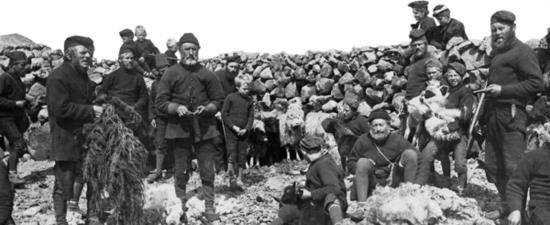
This old photograph of sheep shearers from the Faroe Islands shows how wool was used in many ways. The men are dressed in woolen garments from top to toe.
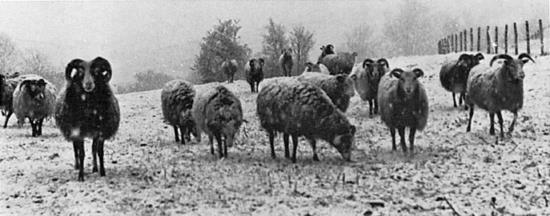
Sheep are out in all kinds of weather. If it rains, the water rolls off their coats. Some of the natural oil in the untreated wool is preserved in the knitting yarn and makes it water repellent. Still, wool can absorb up to 40% of its weight in water without feeling damp. It also absorbs body moisture easily.
From wool to yarn
The sheep are sheared once or twice a year, depending on the breed. There is a difference between annual and semi-annual wool.
Before the wool can be treated, it must be cleaned. Oil, sweat, plant scraps, and other particles can be removed by washing the wool carefully in soft water. Long ago the sheep themselves were washed before being sheared because it was easier to dry the wool while still on the animal.
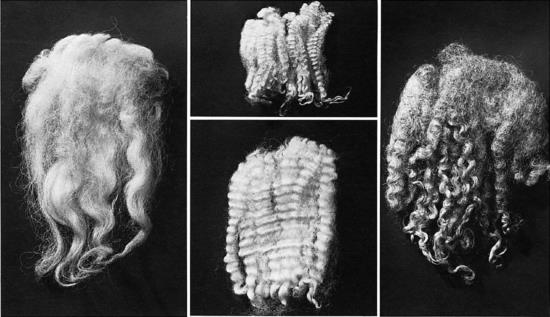
Different breeds of sheep produce different types of wool. Some breeds have thin, frizzy wool and others have straight, coarse wool.
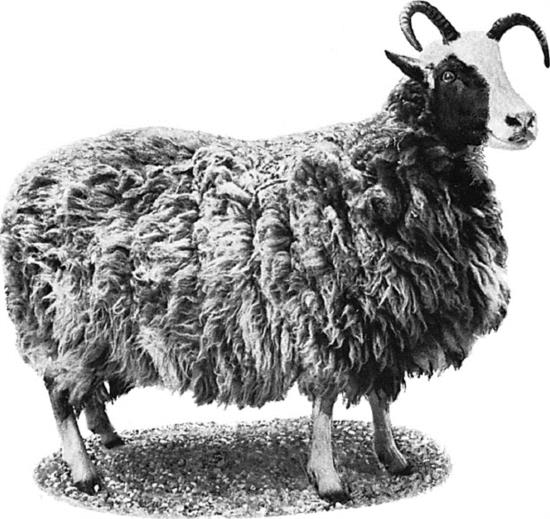
The wool of a sheeps coat is not uniform. It varies according to where it grows on the sheeps body. Usually the best wool comes from the shoulders and sides. Much experience is required to learn to sort and evaluate the wool.
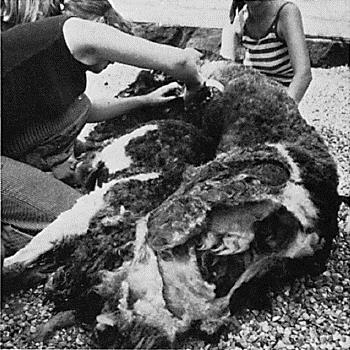
The Gotland outdoor sheep shown here is a breed that is sheared annually. The coat comes off in one piece because the fat content and the kinkiness cause it to hang together.
Spinning principles
The wool can be spun according to two different principles: worsted spinning and card yarn spinning.
Next page
